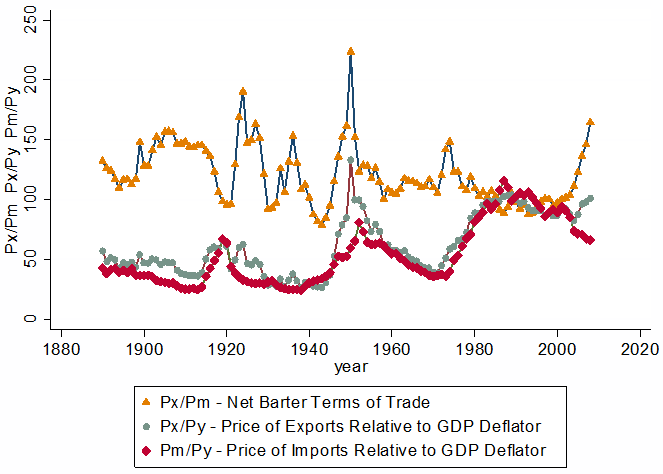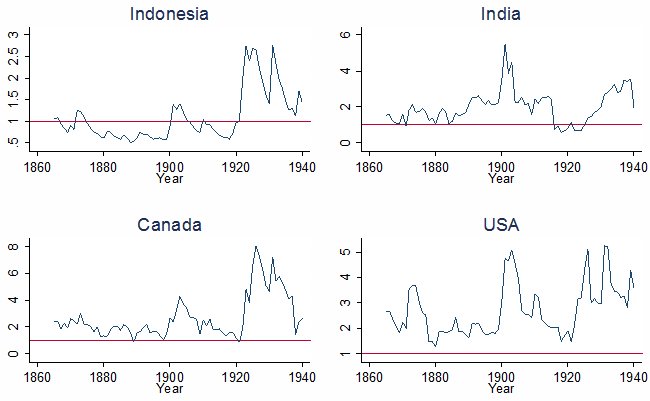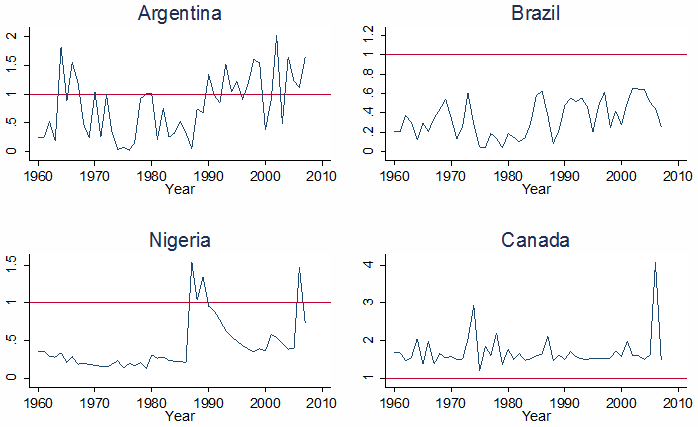Commodity-price shocks have powerful but unequal effects on labour, capital and land. A large literature, often referred to as the ‘Dutch Disease’ literature, documents the effects of commodity booms on factors of production (Corden and Neary 1982). An increase in global commodity demand and a subsequent rise in commodity prices trigger a sharp rise in commodity exports. Typically, this causes an appreciation in the exporter’s real exchange rate which in turn harms competitiveness of other tradeable sectors, like agriculture and manufacturing. As a result, employment in agriculture and manufacturing might decline following a resource boom.
Even though the mechanisms through which resource booms affect employment in a resource-rich economy are well understood, surprisingly little is known about their distributional impact. On the theory front, the distributional impact of a commodity-price shock should be modest if resources are mobile. However, if there are constraints on intersectoral factor mobility then the distributional consequences of a price shock might be significant. This applies with special force to sector-specific factors like natural resources. Furthermore, political-economy theorists assert that natural resources could have a significant impact on distribution through an institution channel (Engerman and Sokoloff 2012, Acemoglu and Robinson 2012, Acemoglu et al. 2005). They argue that natural resources influence the initial distribution of wealth and income, and thus of economic power. The distribution of economic power determines, in turn, the shape of future institutions and policies. Income and wealth inequality might, therefore, persist over the very long run. The nature and magnitude of the impact of natural resources on income and wealth distribution is, however, dependent on the type of natural resources, their initial ownership, and other initial conditions.
New research
The theoretical ambiguity associated with the impact of resource booms on income distribution makes this an ideal empirical question. In Bhattacharyya and Williamson (2013), we address this question by studying the association between commodity prices and income distribution in Australia for a century. The key facts that we discover:
- First, Australia has undergone three major commodity-price episodes over the past century (Figure 1).
Figure 1. Australian terms of trade time series 1890 to 2007
The first half of the 1920s experienced a sharp increase in Australian commodity prices. The second major price shock occurred during the Korean War episode from the late 1940s to the early-mid 1950s and the third is what we have seen since 2003.1 In terms of magnitude, the Korean War boom was the most dramatic.
- Second, the size and frequency of commodity-price shocks experienced by Australia over the periods 1865-1940 and 1960-2007 are in fact bigger than many commodity-exporting developing countries.
Figures 2 and 3 compare Australia’s volatility with that of Indonesia, India, Canada, the US, Argentina, Brazil, and Nigeria over the periods 1865-1940 and 1960-2007 respectively by plotting the ratio of conditional variances. If the ratio is greater than 1 then it implies that Australia experienced more volatility than the country in question: parity in volatility between Australia and the country in question is signified by the horizontal line at the co-ordinate (0,1).
Figure 2. Ratio of conditional variances in commodity prices: Australia and the rest of the world, 1865-1940
Figure 3. Ratio of conditional variances in commodity prices: Australia and the rest of the world, 1960-2007
- Third, after controlling for GDP growth, interwar and wartime conditions, trade-union density, direct tax shares in GDP, and enterprise wage bargaining, the commodity-price shocks increased the income share of the top 1%, 0.05%, and 0.01% considerably both in the long and short run.
- Fourth, wool and mining prices have been the main drivers of Australian inequality in the short run and not other agricultural commodities.
In the long run, however, a sustained increase in the price of renewables (wool) reduces inequality whereas the same for non-renewable resources (minerals) increases inequality.
Resource booms tend to exacerbate inequality
What are the key lessons from this exercise? Our analysis shows that resource booms tend to exacerbate inequality. The recent literature on the economic consequences of inequality argues that high and persistent inequality not only harms growth but also adversely affects institutions (Aghion et al. 1999, Engerman and Sokoloff 2012, Acemoglu and Johnson 2012, Acemoglu et al. 2005). Therefore, it is important for resource-rich developing countries to design appropriate policies to tackle inequality that emerges as a consequence of commodity-export booms. Whether their political economy makes that possible may, of course, be less likely than for mature economies like Australia.
Conclusions
We need good time series data from developing countries to see whether the distributional impact is bigger there than what we find for Australia. Until then, the analysis here seems timely and relevant, not just for Australia, but for all resource-rich developing countries as the price volatility experienced by the former since the late 19th century was greater than that for the average commodity-exporting low-income country.
The distributional impact of commodity-price shocks in Australia (Canada and New Zealand) should yield important lessons for primary producers from the developmental south.
References
Acemoglu, D and J Robinson (2012), Why Nations Fail: The Origins of Power, Prosperity, and Poverty, New York, Cromn Publishers.
Acemoglu, D, S Johnson, and J Robinson (2005), “Institutions as the Fundamental Cause of Long-Run Growth”, Handbook of Economic Growth, 1, 385-472.
Aghion, P, E Caroli, and C Garcia-Penalosa (1999), “Inequality and Economic Growth: The Perspective of the New Growth Theories”, Journal of Economic Literature 37(4), 1615-1660.
Bhattacharyya, S and J G Williamson (2011), “Commodity Price Shocks and the Australian Economy since Federation”, Australian Economic History Review 51(2), 150-177.
Bhattacharyya, S and J G Williamson (2013), “Distributional Impact of Commodity Price Shocks: Australia over a Century”, CEPR Discussion Paper 9582, August.
Corden, W M and J P Neary (1982), “Booming Sector and De-Industrialization in a Small Open Economy”, Economic Journal 92 (December), 825-48.
Engerman, S L and K L Sokoloff (2012), Economic Development in the Americas since 1500: Endowments and Institutions, New York, Cambridge University Press.
1 Bhattacharyya and Williamson (2011) provide a detailed historical account of these episodes.




